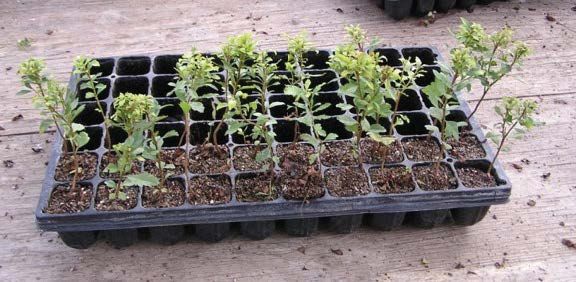Note: This fact sheet is also available as a chapter in a comprehensive manual titled Dune Restoration and Enhancement for the Florida Panhandle, available in pdf form here: https://edis.ifas.ufl.edu/publication/SG156. Please see the manual for more information about other useful and attractive native plants for dunes and for further information about restoration and preservation techniques.
Myricaceae

Credit: Jenna Dunn, UF/IFAS
Wax myrtle is one the most widespread plants in Florida, and it is found in coastal states west to Texas and north to New Jersey. The wax found around seeds can be melted down to make candles. The fruits of wax myrtle are important for birds and other wildlife, and the plant is a larval host for the banded hairstreak and redbanded hairstreak butterflies (Satyrium calanus and Calycopis cecrops, respectively) (Lotts and Naberhaus 2017). Wax myrtle has been shown to contribute substantial nitrogen addition to soils via symbiotic relationships with nitrogen-fixing microorganisms residing in soils (Permar and Fisher 1983).
General Description
Wax myrtle is an evergreen shrub to small tree with several trunks that can reach heights of 40 ft. Leaves are alternate, simple, narrowly oblanceolate, 2 to 6 in long by 0.4 to 0.8 in wide, aromatic, and dense, with a toothed margin toward the apex and surfaces covered in amber dots. It may require magnification to see the dots clearly. Inflorescences are catkins, male or female, axillary, 0.8 in long, numerous, and occur in early spring. The species is dioecious with pistillate and staminate flowers occurring on separate plants. Fruits are rounded, blue, wax-coated drupes 2 to 4 mm in diameter.
Propagation

Credit: Sarah Lumban-Tobing, UF/IFAS
Southern nurseries usually produce wax myrtle from seed or cuttings. It is commonly used as a landscape plant. To propagate cuttings from plants existing on restoration sites, collect softwood cuttings and treat with moderate rates of IBA (Indole-3-butyric acid) at 5,000 to 8,000 ppm or mixtures such as 1,000 ppm IBA and 500 ppm NAA (1-Naphthaleneacetic acid). Root cuttings under intermittent mist; they will show root growth at approximately 4 weeks.
Seed germination requires removal of the wax coating from the fruit. Wash the fruit in warm detergent water and rinse with plain cool water. Seed require a cool, moist stratification period of 40 to 90 days. Seeds can be sown in open flats and covered with ¼ in of vermiculite. Stratification is necessary to overcome physiological dormancy; hence seed from more northern populations may have a longer stratification requirement than southern populations (Krochmal 1974).
Outplanting
The authors have successfully transplanted wax myrtle grown in 1-gal containers to Santa Rosa Island with a survival of 50 to 65% 15 months after planting, when plants were located a minimum of 560 ft from the gulf (Miller, Thetford, and Schneider 2008). Morella was not tolerant of the levels of salt spray when planted closer to the Gulf or when planted behind dunes less than 3.3 to 6.6 ft high. Transplants experienced significant foliar loss and twig death at 660 ft from the gulf when protective dunes were less than 6.6 ft high. Surviving plants exhibited regrowth from the basal portions of the plants, and we concluded that these plants would need additional dune development or should be planted further back from the Gulf within the dune field or located in close proximity to swales.
Plants grown from rooted cuttings in 60-cell flats have been successfully outplanted within the low dune field on barrier islands in the Panhandle of Florida (Lumban Tobing 2009). Plants should be placed at low spots of interdunal swales during the spring and should be initially irrigated if drought conditions are present.
Literature Cited
Krochmal, A. 1974. "Myrica L. Bayberry." In: Schopmeyer, C. S., ed. Seeds of woody plants in the United States. Agriculture Handbook no. 450. Washington: U. S. Department of Agriculture, Forest Service. pp. 548-550.
Lumban Tobing, S.T. 2009. "Germination and establishment of woody species with barrier island interdunal swales." Master's thesis. University of Florida.
Lotts, Kelly, and Thomas Naberhaus, coordinators. 2017. Butterflies and Moths of North America. http://www.butterfliesandmoths.org/
Miller, D.L., M. Thetford, and M. Schneider. 2008. "Distance from the Gulf influences survival and growth of three barrier island dune plants." Journal of Coastal Research 24(3):261–266.
Permar, T.A., and R.F. Fisher. 1983. "Nitrogen fixation and accretion by wax myrtle (Myrica cerifera) in slash pine (Pinus elliottii) plantations." Forest Ecology and Management 5(1):39–46.